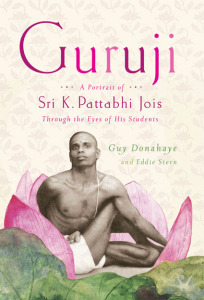Book now
Mysore style astanga self-practice
Mon-Fri 6.15-9am (last entry 7.30am)
Sat 7.30am start (led class last Saturday of each month)
Led Classes
Monday 6pm, Wednesday 6pm & Thursday evenings 7.30pm
Friday evenings 6pm

Book Review by Clara Murphy, YogabaseBrighton student ‘Guruji: A portrait of Sri K. Pattabhi Jois through the eyes of his students’ by Eddie Stern and Guy Donahaye
“Yoga is showing where to look for the soul–that is all” (Sri K. Pattabhi Jois, 2001)
This book is unique glimpse of the man behind the title of ‘Guruji’ (Pattabhi Jois), through the words of some of his earliest Western students and close relations.
Predominantly in interview format, the book offers some fascinating insights from practitioners such as David Williams, Nancy Gilgoff, David Swenson, and many more who have gone on to
become some of the West’s most respected teachers.
I think it’s on hearing from these various practitioners and reading about their own different experiences learning and practising with Guruji that the power of this book really comes alive. Jois becomes much more than merely an abstract figure clouded in awe and mystique. Instead we begin to get a picture of a man who was also a father and husband.
We learn about the special people in Guruji’s life, like Amma his wife, who is talked about almost as fondly and with as much reverence by the interviewees as her husband. Manju Jois describes his mother as “being the backbone of my father…she was always there to soften him”. Nancy Gilgoff describes the special moments she shared with Amma, recalling the times she would sit outside after her practice whilst this pleasant Indian woman (who spoke little English) braided her hair. We hear of Guruji’s first trips to America and being bought his first pair of ‘western trousers’!
But as well as these intimacies, we are also given a window into his teaching, his incredible knowledge about spirituality and philosophy in regards to yoga, and how he passed this down to his students. Fiercely intelligent, one of Jois’ greatest skills was to show that the language of yoga could be universally understood; all you need is a willingness to practise it.
Brad Ramsay describes Jois as seeming to have an innate understanding of the body, a unique mastery at motivating his students, and a resolute desire to pass the lineage of the Astanga method on.
David Swenson says that one of Jois’ greatest skills in teaching was being able to convey “the essence, beauty and strength and power and the dynamic nature of this system in such a way that people of all levels” could understand it and that “he’s made yoga accessible”.
Through these interviews we gain an understanding of what Astanga yoga truly meant to Guruji, the importance it held for him, and just how it infiltrated every aspect of his life and those around him. Everyday family life and work all centred around the practice and his teaching of it. The way in which Guruji chose to carry out his life illustrates Astanga yoga in its purist form: No gimmicks, no ‘selfies’ or merchandise, just the practice as it is.
What has struck me in reading the various accounts from those who practised with Jois and one of the reasons I have lingered on each chapter, is the genuine love that all of these different people had for him. The respect and unyielding admiration that he seemed to effortlessly provoke, both as a man and through his teaching.
Many interviewees remind us how he lived by his famous quote “One percent theory, 99 percent practise” because, for Jois, the ‘practice’ really was the essence to our very being. Through practise, through the intensely physical, asana-based Astanga system, we come to understand it as actually a deeply spiritual practice, a healing practice. I found it very touching and inspiring to hear just what a powerful and admirable man he was and I felt a real sense of loss that he is no longer alive.
This book also gets to the heart of what Astanga yoga has meant to the various practitioners interviewed both on a personal level and reveals how they have evolved as people through the practice. They share their own perspectives, interpretations of Astanga yoga, the challenges they have come up against and just what keeps them wedded to it. Tim Miller gives a nice summary about the rewards or joy of daily practice:
“It keeps me connected to a process that is life-giving, light-giving and health-giving. Staying connected to the practice for me just ensures that this evolutionary process continues to unfold itself in some kind of organic way, creating greater health, greater wealth, greater possibility, greater opportunity, greater things”.
I finished this book feeling truly humbled and privileged to be practicing Astanga yoga. I think that, whether you practise yoga or not, practise Astanga or not, opening any chapter of this book will give you something to contemplate, to think about and evaluate.
We are given in this book a portrait of a great teacher, his legacy and gift he bestowed on those who chose to take up the practice and live it. Guruji taught that it’s not about being better than anyone else, or achieving physical peaks. To quote Nick Evans, “it is ultimately about being a kinder, nicer, loving person”.
………………
Enjoy this book review? Let us know what you think or share it on social media.
Mon-Fri 6.15-9am (last entry 7.30am)
Sat 7.30am start (led class last Saturday of each month)
Monday 6pm, Wednesday 6pm & Thursday evenings 7.30pm
Friday evenings 6pm